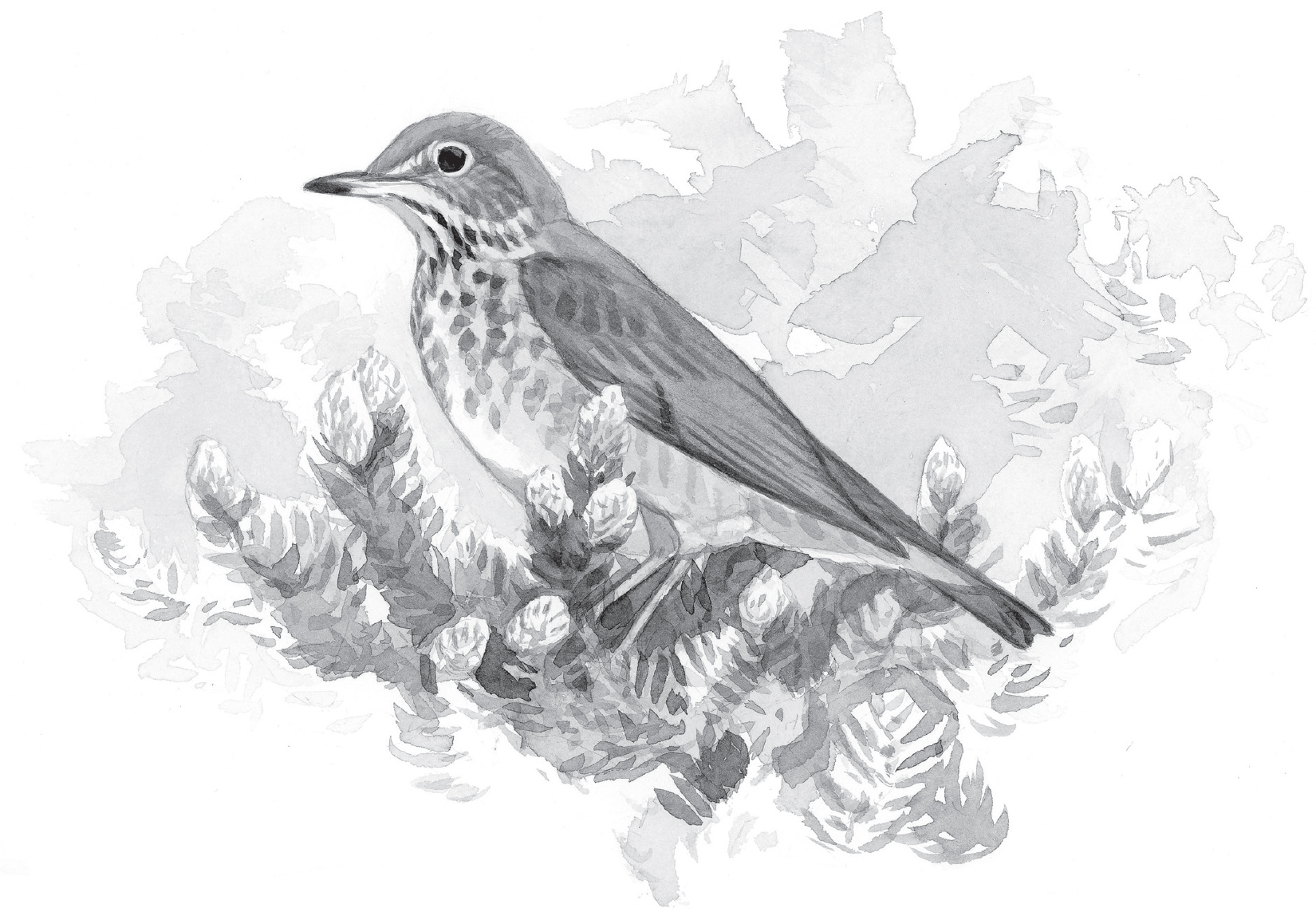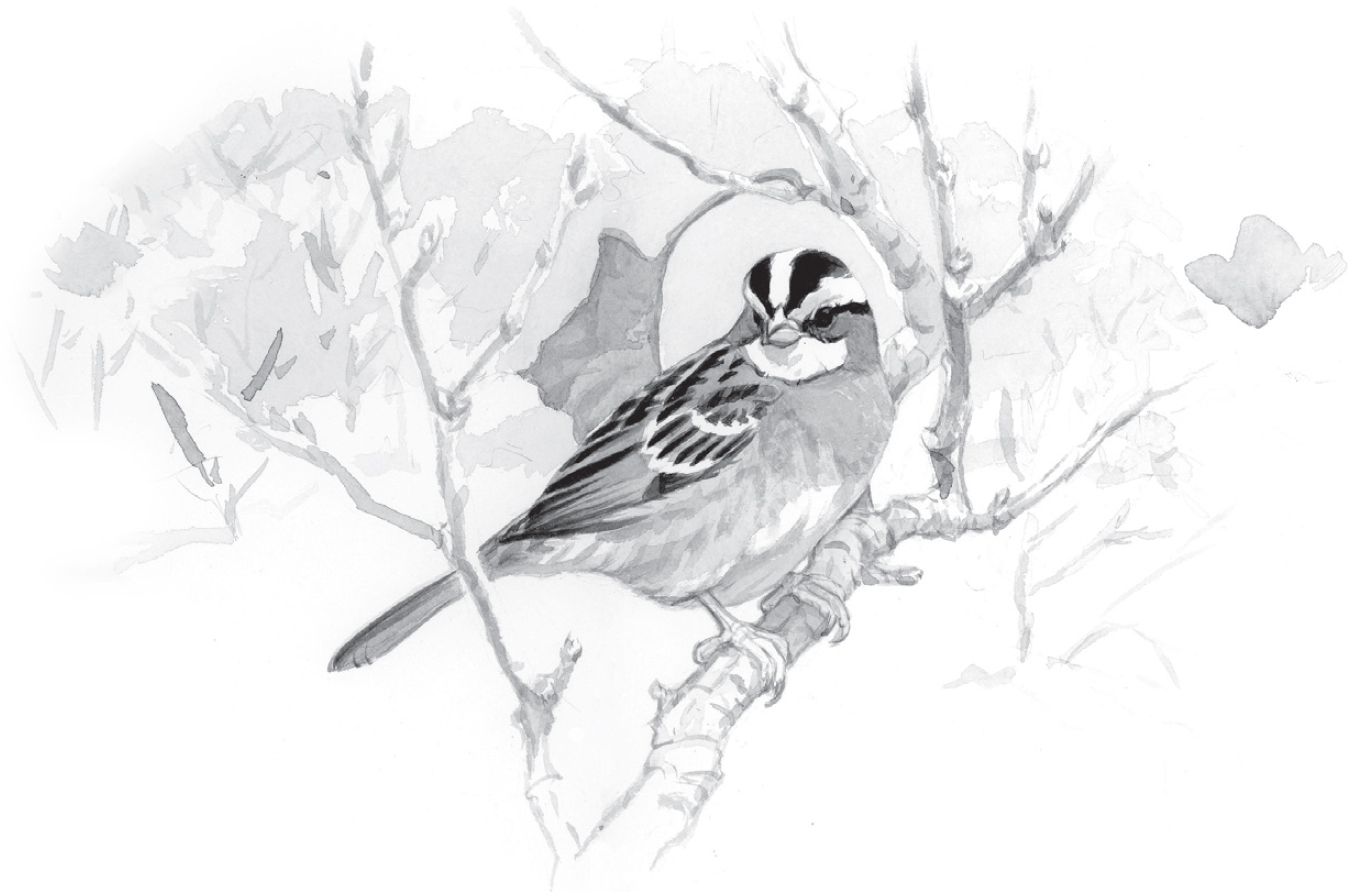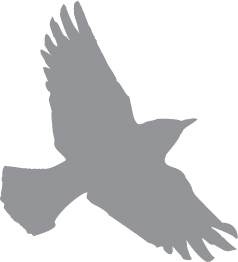EPILOGUE

Swainson’s Thrush
Here in this wild and beautiful spot amid the mountains, the dark woods, the rising mist, the new moon hanging above the silhouettes of the peaks, we waited, in spite of the night chill, until the last sunlight of the spring had ebbed from the sky.
—EDWIN WAY TEALE, North with the Spring
From my Adirondack campsite, I drive home, heading into the glossy blue-gray skies of the hot Mid-Atlantic, where cicadas drone in the afternoons and pop-up evening thunderstorms douse suburban yards. I spend my last night on the road camping at Shawnee-on-Delaware, at the Water Gap in eastern Pennsylvania, where I listen to the songs of summer birds—Indigo Buntings, Yellow-throated Vireos, and Great Crested Flycatchers. Spring is done, finally, for me.
I think back to my brief stay on the summit of Algonquin Peak, where I’d called in to chat live with Ray Brown on his Sunday-morning radio show, Talkin’ Birds. It had given me a chance to reminisce about my three months on the road, driving 12,891 miles, biking several hundred miles, kayaking several dozen more, and walking some unknown but substantial distance. I’d encountered 259 species of birds, including all 37 quest warblers, along the way. I told Ray’s audience that my trip was all about the nature of “place.” The long road trip had brought me to an array of marvelous southern destinations, led me to a lonely Jack Pine forest in Canada, and ended in a place filled with treasured childhood memories. Many of the southern locales were special for their novelty. The sojourn in northern Ontario took me to a distant land that fell short of my high expectations but nonetheless surprised and educated me. The last place I visited harkened back to my past. It was fine to end my journey in the Adirondacks—as wild and bountiful as it had been when I spent my first summer there as a twelve-year-old.
Plenty of writers out there have cataloged the environmental losses we have suffered since the 1960s. There’s no denying that we have forever lost some of our precious natural heritage over the ensuing decades. At the same time, however, there have been conservation successes, both small and large, and we have discovered more about nature’s capacity to restore itself. Today, after all, there is more forest land under conservation in the Adirondacks than there was in 1964, when I first visited. That’s good news. We must remain hopeful and continue to work to conserve and restore what we love.
My wondrous experiences in the Tensas Basin, Delta National Forest, Wyalusing State Park, Crex Meadows, and Pukaskwa National Park showed me that North America remains filled with unique green spaces worth visiting and protecting. Seeing a singing Connecticut Warbler in northern Ontario was fantastic but no less special than seeing a singing Bicknell’s Thrush on Algonquin Peak. There are many tantalizing bird encounters to be had on this broad continent, and we can all be out exploring our favorite old haunts and discovering new destinations near and far. It makes our souls sing, and it keeps us young at heart.
On the nature conservation front, there is work to be done. For the beloved Neotropical migratory songbirds, the challenge is clear: we must pull together to conserve, restore, and expand critical blocks of forest habitat that the birds require for their breeding territories, their winter homes, and their various stopover sites in between. These blocks of habitat should be doubled or tripled in size. If we succeed in this big task, we can reverse the decline of our songbirds and bring them back to the abundance celebrated by Edwin Way Teale in his 1951 book. We need to throw our support behind institutions working on behalf of nature in North America—ones such as the Houston Audubon Society, the American Bird Conservancy, the Texas Parks and Wildlife Department, the Smithsonian Migratory Bird Center, and the U.S. Fish and Wildlife Service, to name only a few.
In many places, we have moved in the right direction. Think again of the Adirondacks: when young Theodore Roosevelt first did his bird studies there in the 1870s, not a single acre had been protected. In 1885, as governor of New York, Roosevelt created the Adirondack Preserve—a first step. Coincidentally, Roosevelt, by then vice president, was climbing Mount Marcy in the Adirondack High Peaks in 1901 while President William McKinley lay in the hospital, felled by an assassin’s bullet; McKinley soon died, making Roosevelt president. Roosevelt’s love of the Adirondacks and other wild places in America inspired him to create the first national parks, based on the Adirondack model.

White-throated Sparrow
At the time of Roosevelt’s presidency, many private forest tracts in the Adirondacks were being heavily logged, and large-scale timber felling was happening in Michigan, Wisconsin, and Ontario. Today many of the areas logged in the early 1900s are classified as protected forest, never to be logged again. Yes, the ancient forests—the virgin woods—are mostly gone from the East, but the expansion of mature forest cover throughout the East has risen relentlessly since the 1930s. Today its extent is considerably greater than it was in the year 1800. Wildlife species that were completely extirpated from the East, such as the Wild Turkey, Fisher, and North American Beaver, are now back in force, settling in suburbs and visiting backyards. Let’s never forget Nature’s regenerative capacities. Were Edwin Way Teale alive today, he would be amazed at the regreening of the East, especially in and around urban areas. That said, he probably would express worry over the future of the Neotropical songbird migration phenomenon. He would be surprised by the impact of human demography on the forests of Central America, northern South America, and the insular Caribbean. He would, I believe, assert the need for every citizen to take notice and to work to conserve or restore those special green spaces that still exist. Reaching out to our compatriots south of the U.S. border is something we need to do more, sharing best practices and helping our counterparts in the Tropics to see the biotic linkages that migration produces. They must conserve their backyard as we continue to conserve ours. Organizations such as the American Bird Conservancy are working with partners to bring about full-life-cycle conservation of migratory birds. Conservation biologists such as Pete Marra and his research team at the Smithsonian are continuing to ask the questions that help us to better understand the mechanics of migration and the particular points of vulnerability that need shoring up. Such understanding will inform the actions we’ll take to reduce the threats posed by lighted tall buildings, transmission towers, wind turbines, and free-roaming cats—as well as the more familiar threat of habitat loss.

I remain hopeful. This hope may come with age and experience; comparing my encounters with wild nature in the Mid-Atlantic region in the 1960s to those I’ve had today is enlightening. In the spring of 2016, a family of five Common Ravens (our largest songbird) spent several weeks in my suburban neighborhood, adjacent to the Potomac River and Washington, D.C. By contrast, in the 1960s, a raven was a very rare sight anywhere east of the high, rocky ridges of the Appalachians. In the same vein, today Bald Eagles nest along the Potomac River and pass overhead in and around the nation’s capital on a regular basis. I counted more than twenty-five of them on a recent Christmas Bird Count on the Virginia side of the mid-Potomac. By contrast, a Bald Eagle would have been a rare sight indeed along the Potomac in the 1960s. The same story can be told of the Osprey, the Peregrine Falcon, and a number of other once imperiled species.
I see reason for hope, but I also make a plea for vigilance on behalf of wild nature. More citizens’ action, undertaken by more of us working in concert, can lead us to a new and better world. Let’s all raise the flag for wilderness, wood warblers, and all things wild.